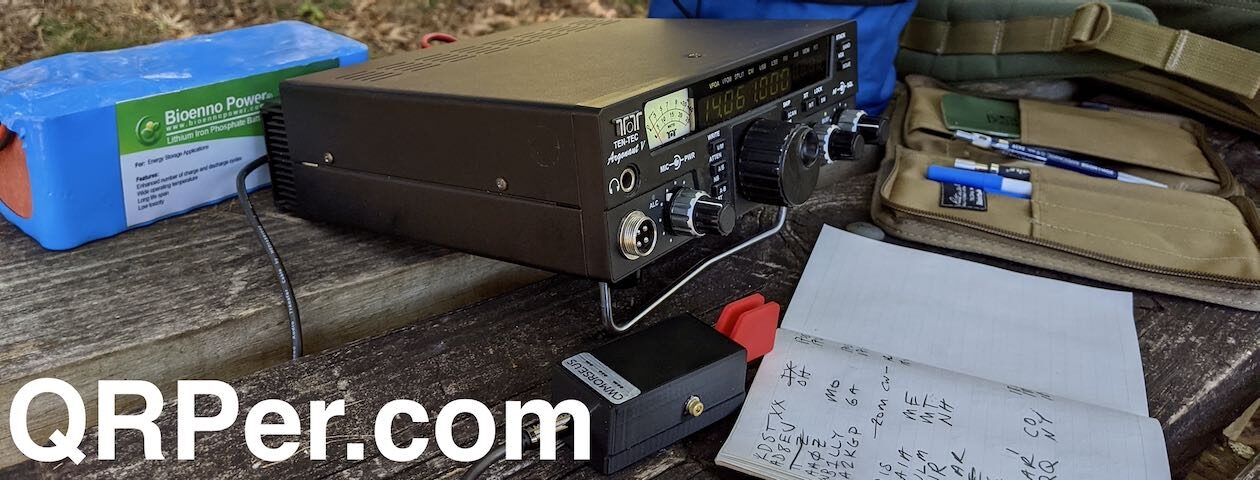
Many thanks to Leo (DL2COM) who writes:
Thomas,
Today was crazy: when I woke up I thought it would be a good idea to attempt a first activation of DA-0171 in central Berlin after dropping off the kids at day care. So I grabbed my KX2 bag and jumped on my bike.

Shortly later I arrived at the park and pulled up my 40-10m EFHW and started calling CQ on SSB 40m.

It took me about 30 mins to realize that the KX2 was regulating the power down to 5W since both the internal and the external 4Ah battery I took with me were nearly dead.
I had one QSO with a German station and felt I wasn’t really heard anywhere. Then my KX2 started showing “low batt”.
It’s funny because attempting an activation isn’t really what one would call a very important thing, but I do develop quite an ambition if I have decided to get it done. So my only chance was using CW even though I am all but ready for that.
Having read your article about auto-spotting and watched many of your videos including POTA QSO style I didn’t think long and started calling CQ POTA on 20m.
OMG what followed was just amazing!
Fortunately I didn’t run into a classic pileup which would have been super overwhelming for me, but instead about every 2 minutes someone would reply to my call and in a very patient fashion – including one P2P QSO with an operator from Italy.
So all in all I completed 13 QSOs on a “low batt” warning of my KX2.

CW literally saved by butt and I am a very happy person. Without your work for the ham radio community this would not have been possible. So many thanks again.
On a different note: Last weekend (kit building seminar with the club) I had my first DX QSO. It was K3LU who picked up my call from my KX2 and a random wire 9:1 Unun antenna (L-Shape on a mast) with 28 and 17ft legs. I had to sit down and open a beer not able to do anything for about an hour but smile. Such a motivating event and I am happy he was such a great operator instantly QRSing with me and repeating his call. I am in touch with him and looking forward to receive his QSL card which will probably go in a frame.
I also finished the TR-35 and must say I am super impressed. It runs very quietly and the reduced concept is something I really appreciate. When will you take it into the field?
All the best & 73s de Leo (DL2COM)
Oh wow, Leo! I love this–thank you so much for taking the time to share your experience.
First of all, thank you for the kind comments–I’m honored to have even played a minor role in your CW activation. In truth, this is all chalked up to your determination and bravery! I’m guessing what you discovered is what I discovered during my first CW activation: not only is it not as bad as I had imagined, but it was actually fun and got the adrenaline pumping! 
I’m now happy to know that when I hit the Low Battery warning on my KX2, I still have some time left! In truth, the KX2 is so efficient, I’ve made six individual CW 5 watt activations on one charge of the internal battery without even hitting the low battery warning.
Again, this story just makes my day. CW is such a fabulous, efficient, and magical mode! Good on you for diving in, OM!
I also think it’s brilliant that you worked Ulis (K3LU). You couldn’t have worked a better op for your first CW contact–he’s the real deal and a wonderful fellow. Not only that, but he has some amazing QSL cards!
And the TR-35? I couldn’t agree with you more. I did an activation with the TR-35 last Friday so a video and field report is forthcoming!
Thank you again, Leo! I hope others share their experience hitting CW for the first time (hint, hint!).
 I’m very honored to be featured with my good friend Wlodek (US7IGN) in a short radio documentary on BBC Radio 4 today.
I’m very honored to be featured with my good friend Wlodek (US7IGN) in a short radio documentary on BBC Radio 4 today.




















